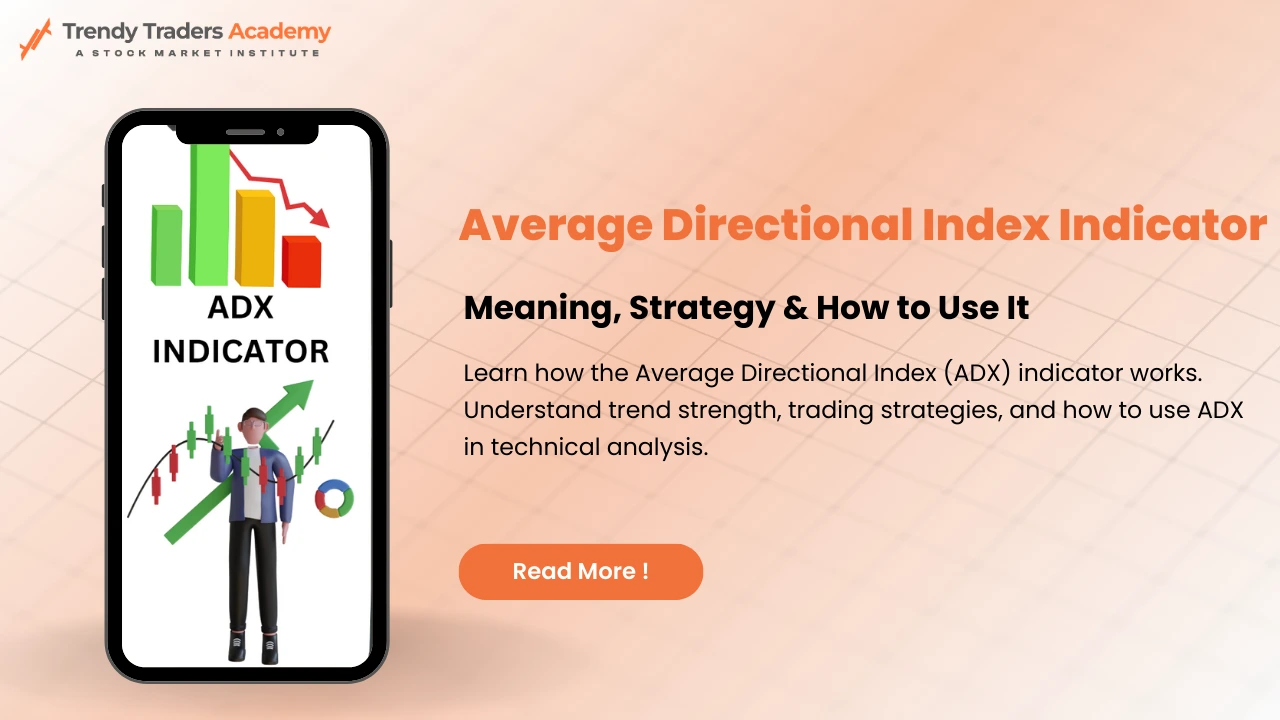
Average Directional Index (ADX) Indicator: Meaning, Strategy & How to Use It
In the fast-changing world of exchanging financial instruments, it is of prime importance to develop the capacity to identify opportunities of trend patterns. The Average Directional Index (ADX), developed by J. Welles Wilder in his book on ‘New Concepts in Technical Trading Systems’ published in 1978 helps traders in providing a precise measure of trending strength. It means that the Average Directional Index indicator gives the traders useful recommendations concerning the further actions at market – the time to enter a trade or leave the position.
In this article, you will be able to read a fairly general definition of Average Directional Index, as well as find out the characteristics of this indicator, the formula, and the ways of its application. We will also discuss how one can make good use of Average Directional Index with a view of enhancing its application in trading.
What is Average Directional Index?
Technical traders use the Average Directional Index indicator as a tool to detect how strong the current trend becomes without considering trend direction. This indicator distinguishes itself from other price-based tools because it focuses exclusively on strength measurement within trends. The trends strength increases when the ADX value grows which signals opposite changes in trend power.
Traders determine market conditions through the ADX indicator which values range between 0 to 100.
0–20: Indicates a weak trend or a sideways market.
20–40: Reflects a moderately strong trend.
40+: Signals a strong trend, making it ideal for trend-following strategies.
Understanding what is Average Directional Index allows traders to incorporate it into broader analyses, whether in forex, commodities, equities, or indices.
Key Components of the Average Directional Index
The Average Directional Index is part of Wilder’s Directional Movement System, which also includes two companion indicators:
+DI (Positive Directional Indicator):
Measures the strength of upward price momentum.
-DI (Negative Directional Indicator):
Quantifies the intensity of downward price movement.
ADX Line:
Combines smoothed averages of the +DI and -DI, reflecting the overall trend strength.
These components work in harmony to provide a comprehensive view of market behavior.
The Average Directional Index Formula Explained
Understanding the Average Directional Index formula is vital for comprehending its effectiveness. Let’s break down the calculation:
True Range (TR):
The True Range measures the greatest price movement during a period, including gaps. It is calculated as the maximum of:
Current High – Current Low,
Current High – Previous Close,
Current Low – Previous Close.
Positive and Negative Directional Movements (+DM and -DM):
+DM captures upward price changes and is calculated as: $$+DM = Current High – Previous High \ \text{(if positive and greater than -DM)}$$
-DM reflects downward price movement: $$-DM = Previous Low – Current Low \ \text{(if positive and greater than +DM)}$$
Smoothed Averages:
Use a moving average (often 14 days) to smooth the TR, +DM, and -DM.
Directional Indicators (+DI and -DI):
+DI = (Smoothed +DM / Smoothed TR) × 100
-DI = (Smoothed -DM / Smoothed TR) × 100
Directional Movement Index (DX):
$DX = \frac {|+DI – -DI|} {(+DI + -DI)} \times 100$
Average Directional Index (ADX):
Smooth the DX values over the desired period to calculate the ADX.
This structured calculation forms the backbone of the Average Directional Index indicator, making it a reliable measure of trend strength.
How to Use Average Directional Index Effectively
To unlock the full potential of the ADX, traders should integrate it smartly into their trading strategies:
Identifying Market Trends:
When the ADX measures lower than 20 points it signifies market stability without trends which suggests trend-based methods will not work well. A trend with an ADX value exceeding 40 confirms robust price movements which provide favorable circumstances for permanent position trading.
Enhancing Trade Signals:
The ADX is most powerful when combined with other technical indicators. For instance:
Pair ADX with RSI to confirm overbought or oversold conditions.
Use it alongside MACD to validate momentum shifts.
Strategic Entry and Exit:
When the ADX surpasses 25 it indicates that a new trend is starting thus presenting a valuable entry point. When ADX falls beneath 20 points it shows that the current trend is progressing towards a weakening state therefore traders should think about closing their active trades.
Average Directional Index provides traders with a tool to build better trading approaches while decreasing risk levels and effectively participating in long-lasting trend movements.
Advantages of the Average Directional Index
Objectivity:
The ADX gives us a data-driven measure of trend strength, minimize emotional biases while in trading decisions.
Versatility:
The indicator is united with various asset of classes, making it a universal tool for traders as well as for investors.
Compatibility:
The ADX works seamlessly with other technical indicators, Also traders to build strong strategies.
Limitations of the Average Directional Index
While the Average Directional Index indicator is a valuable tool, it is not without its drawbacks:
Lagging Nature:
As a trend-following indicator, the ADX relies on historical price data, making it less effective for predicting future market movements.
Limited Use in Ranging Markets:
The ADX does not indicate price direction, which can render it less useful in sideways or non-trending markets.
Understanding these limitations ensures that traders can apply the ADX more effectively while mitigating its shortcomings.
- Backtesting is testing a strategy on historical data.
- Paper Trading is testing a strategy in a simulated live market environment.
Conclusion
The Average Directional Index (ADX) is considered to be very helpful for those traders who focus on trading in the financially given directions. In this regard, by pointing out the strength of any given trend, it offers regulators that may help in the development of trading strategies irrespective of the market type. It is crucial for both novices and experienced traders to know what is Average Directional Index, properly understand Average Directional Index formula as well as learn how to use Average Directional Index in trading.
In his note, the ADX is not flawless, however, when used in conjunction with other tools and approaches, it should remain a valuable tool in any trader’s equipment. Trade properly, maintain your knowledge, and let the ADX reveal the best instructions to trade powerful trends.
Also Read : Zomato Share Price 2025
FAQ'S
What is the Average Directional Index Indicator ?
Average Directional Index Indicator (ADX) is used by traders to identify strong trends in the market. It helps in avoiding sideways or weak trends.
What is the Average Directional Index Formula ?
The Average Directional Index formula is:
ADX = 100 × (EMA of |(+DI) – (-DI)|) / ((+DI) + (-DI))
It uses smoothed moving averages of directional movement indicators.
Is Average Directional Index useful for trading ?
Yes, Average Directional Index helps traders identify the strength of a trend, which is crucial for timing entries, exits, and avoiding choppy markets.
Can I use Average Directional Index for intraday trading ?
Yes, Average Directional Index indicator can be used for intraday trading, especially when combined with other indicators like RSI or MACD for confirmation.
What is a good ADX value for trend trading ?
Typically, ADX above 25 indicates a strong trend. Values between 20-25 are neutral, and below 20 suggest a weak trend or range-bound market.











